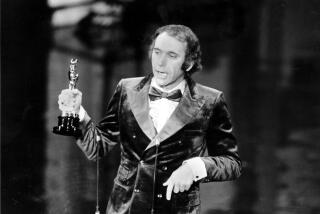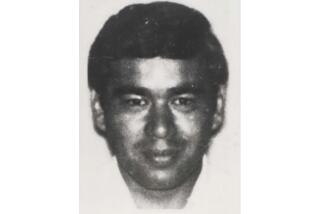His Death Was a Good Career Move
- Share via
Frontier bandit Elmer McCurdy, dead these 86 years, just can’t stay out of the limelight.
A bit more than two decades ago, McCurdy’s mummified body was found in a fun house attraction at the old Long Beach Nu-Pike amusement park. It was during the filming of an episode of TV’s “Six Million Dollar Man.” A technician rearranged what was thought to be a mannequin, only to have one of McCurdy’s arms fall off.
Now, the BBC is researching the life--and afterlife--story of McCurdy for a special for its “Timewatch” history series. The program, scheduled to be broadcast next year, will “focus on the use of mummies by exploitation movie makers and in sideshows in the ‘20s, ‘30s, and ‘40s,” said assistant producer Rebecca Lewis.
Lewis added that the BBC is looking for people with information about the 5-foot, 3-inch badman.
McCurdy, killed in 1911 after his last robbery (see photo), was subsequently mummified and propped up at carnivals as well as in theater lobbies for such early century low-budget films as “Narcotic” and “Forbidden Adventure.”
At least the BBC won’t have trouble finding McCurdy. His wanderings ended when he was buried in 1977 in the Boot Hill section of the Oklahoma Territorial Museum in Guthrie. A museum official said at the time: “We have him under 2 1/2 yards of concrete. He’s not going to get away this time.”
So far, so good.
MEMORABLE EXITS: Some historians speculate that McCurdy was drunk--and possibly unconscious--when he was shot to death by a posse. But one of his Boot Hill companions made a more memorable exit. Gambler Tom Capers, shot during a crap game, reportedly died after declaring: “Capers craps out!”
MORE FITTING FOR ELMER’S BUCKBOARD: John Errera of Rancho Palos Verdes came across an ad for a 1998 Cadillac that seems to be lacking in some of the comfort areas (see excerpt). But perhaps it’s good for bad backs.
CROSS-CULTURAL LANGUAGE CLASHES (CONT.): Adam Tschorn of Los Angeles recalled the time he spent a night in Chinle, Ariz., where a Native American artisan “unrolled a very large, beautifully woven blanket which he described as a ‘Navajo Cheese Blanket.’ ”
“The term struck me as a bit odd,” Tschorn continued, “and after several additional references to this intricate and expensive ‘cheese blanket’ my curiosity got the best of me. I asked our host and the weaver what sort of ceremony the ‘cheese blanket’ was used for. After a moment of awkward silence, our host looked at me with a smile and said, ‘It’s a Navajo chief’s blanket.’ ”
Tschorn added: “Needless to say it seems infinitely funnier now than it did at the time. . . .”
miscelLAny
Fifty years ago this week--Nov. 2, 1947--Howard Hughes piloted the 218-foot-long Spruce Goose on its only flight, a 49-second journey of about one mile over Long Beach Harbor. As it happens, I viewed the spectacle during a visit to relatives who lived along the ocean. And I cried through the entire flight. Perhaps I cried because I was overcome by the historic nature of the incident. Or perhaps it was because I was 19 months old.
More to Read
The complete guide to home viewing
Get Screen Gab for everything about the TV shows and streaming movies everyone’s talking about.
You may occasionally receive promotional content from the Los Angeles Times.






